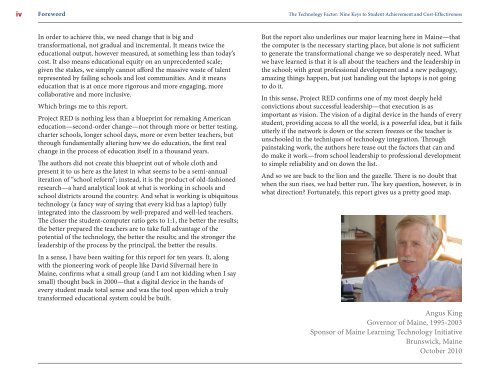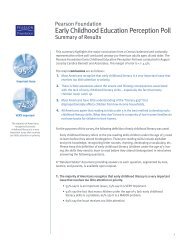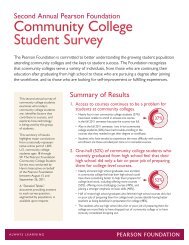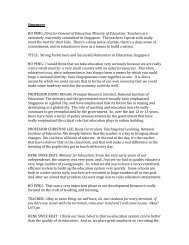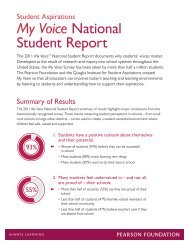The Technology Factor: Nine Keys to Student Achievement and Cost ...
The Technology Factor: Nine Keys to Student Achievement and Cost ...
The Technology Factor: Nine Keys to Student Achievement and Cost ...
You also want an ePaper? Increase the reach of your titles
YUMPU automatically turns print PDFs into web optimized ePapers that Google loves.
iv Foreword<br />
In order <strong>to</strong> achieve this, we need change that is big <strong>and</strong><br />
transformational, not gradual <strong>and</strong> incremental. It means twice the<br />
educational output, however measured, at something less than <strong>to</strong>day’s<br />
cost. It also means educational equity on an unprecedented scale;<br />
given the stakes, we simply cannot afford the massive waste of talent<br />
represented by failing schools <strong>and</strong> lost communities. And it means<br />
education that is at once more rigorous <strong>and</strong> more engaging, more<br />
collaborative <strong>and</strong> more inclusive.<br />
Which brings me <strong>to</strong> this report.<br />
Project RED is nothing less than a blueprint for remaking American<br />
education—second-order change—not through more or better testing,<br />
charter schools, longer school days, more or even better teachers, but<br />
through fundamentally altering how we do education, the first real<br />
change in the process of education itself in a thous<strong>and</strong> years.<br />
�e authors did not create this blueprint out of whole cloth <strong>and</strong><br />
present it <strong>to</strong> us here as the latest in what seems <strong>to</strong> be a semi-annual<br />
iteration of “school reform”; instead, it is the product of old-fashioned<br />
research—a hard analytical look at what is working in schools <strong>and</strong><br />
school districts around the country. And what is working is ubiqui<strong>to</strong>us<br />
technology (a fancy way of saying that every kid has a lap<strong>to</strong>p) fully<br />
integrated in<strong>to</strong> the classroom by well-prepared <strong>and</strong> well-led teachers.<br />
�e closer the student-computer ratio gets <strong>to</strong> 1:1, the better the results;<br />
the better prepared the teachers are <strong>to</strong> take full advantage of the<br />
potential of the technology, the better the results; <strong>and</strong> the stronger the<br />
leadership of the process by the principal, the better the results.<br />
In a sense, I have been waiting for this report for ten years. It, along<br />
with the pioneering work of people like David Silvernail here in<br />
Maine, confirms what a small group (<strong>and</strong> I am not kidding when I say<br />
small) thought back in 2000—that a digital device in the h<strong>and</strong>s of<br />
every student made <strong>to</strong>tal sense <strong>and</strong> was the <strong>to</strong>ol upon which a truly<br />
transformed educational system could be built.<br />
<strong>The</strong> <strong>Technology</strong> <strong>Fac<strong>to</strong>r</strong>: <strong>Nine</strong> <strong>Keys</strong> <strong>to</strong> <strong>Student</strong> <strong>Achievement</strong> <strong>and</strong> <strong>Cost</strong>-Effectiveness<br />
But the report also underlines our major learning here in Maine—that<br />
the computer is the necessary starting place, but alone is not sufficient<br />
<strong>to</strong> generate the transformational change we so desperately need. What<br />
we have learned is that it is all about the teachers <strong>and</strong> the leadership in<br />
the school; with great professional development <strong>and</strong> a new pedagogy,<br />
amazing things happen, but just h<strong>and</strong>ing out the lap<strong>to</strong>ps is not going<br />
<strong>to</strong> do it.<br />
In this sense, Project RED confirms one of my most deeply held<br />
convictions about successful leadership—that execution is as<br />
important as vision. �e vision of a digital device in the h<strong>and</strong>s of every<br />
student, providing access <strong>to</strong> all the world, is a powerful idea, but it fails<br />
utterly if the network is down or the screen freezes or the teacher is<br />
unschooled in the techniques of technology integration. �rough<br />
painstaking work, the authors here tease out the fac<strong>to</strong>rs that can <strong>and</strong><br />
do make it work—from school leadership <strong>to</strong> professional development<br />
<strong>to</strong> simple reliability <strong>and</strong> on down the list.<br />
And so we are back <strong>to</strong> the lion <strong>and</strong> the gazelle. �ere is no doubt that<br />
when the sun rises, we had better run. �e key question, however, is in<br />
what direction? Fortunately, this report gives us a pretty good map.<br />
Angus King<br />
Governor of Maine, 1995-2003<br />
Sponsor of Maine Learning <strong>Technology</strong> Initiative<br />
Brunswick, Maine<br />
Oc<strong>to</strong>ber 2010


